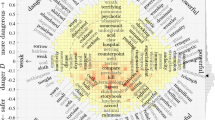Abstract
This paper studies the problem of detecting multiplechanges at unknown times in the mean level of elision in thetrimeter sequences of the Orestes, a play written by theAncient Greek dramatist Euripides (485–406 B.C.). Change-detection statistics proposed by MacNeill (1978) and Jandhayala and MacNeill(1991) are adopted for this purpose. Analysis of the trimetersequences yields several points of change. A general explanation fortheir occurrence appears to be that Euripides varies his use ofelision according to the emotional content of his text, i.e., heseems to change the form to support the content and, thus, seems touse elision frequency as a dramatic instrument.
Similar content being viewed by others
References
Allen, W.S. Accent and Rhythm. Prosodic Features of Latin and Greek: A Study in Theory and Reconstruction. Cambridge: Cambridge University Press, 1973.
Chernoff, H. and S. Zacks. “Estimating the Current Mean of a Distribution Which is Subject to Changes in Time”. Annals of Mathematical Statistics, 35 (1964), 999–1018.
Csörgo, M. and L. Horváth. “Non-Parametric Methods for Change-Point Problems”. In Handbook of Statistics, Vol. 7. Ed. P.R. Krishnaiah and C.R. Rao. New York: North-Holland, 1988, pp. 403–425.
Dale, A.M. The Lyric Metres of Greek Drama. Cambridge: Cambridge University Press, 19672.
Devine, A.M. and L.D. Stephens. The Prosody of Greek Speech. New York, Oxford: Oxford University Press, 1994.
Diggle, J. (ed.). Euripides Fabulae, Oxford Classical Texts Vol. III. Oxford: Clarendon Press, 1994.
Esterby, S.R. and A.H. El-Shaarawi. “Inference about the Point of Change in a Regression Model”. Journal of Applied Statistics, 30 (1981), 277–285.
Gardner, L.A. “On Detecting Changes in the Mean of Normal Variates”. Annals of Mathematical Statistics, 72 (1969), 180–186.
Hawkins, D.M. “Testing a Sequence of Observations for a Shift in Location”. Journal of the American Statistical Association, 72 (1977), 180–186.
Hinkley, D.V. “Inference about the Change Point from Cumulative Sums Tests”. Biometrika, 58 (1971), 509–523.
Horváth, L. “Maximum Likelihood Method for Testing Changes in the Parameters of Normal Observations”. Annals of Statistics, 21 (1993), 671–680.
Jandhyala, V.K. and I.B. MacNeill. “Tests for Parameter Changes at Unknown Times in Linear Regression Models”. Journal of Statistical Planning and Inference, 27 (1991), 291–316.
Kander, Z. and S. Zacks. “Test Procedures for Possible Changes in Parameters of Statistical Distributions Occurring at Unknown Time Points”. Annals of Mathematical Statistics, 37 (1966), 1196–1210.
Kitto, H.D.F. “Sophocles, Statistics, and the Trachiniae”. American Journal of Philology, 60 (1939), 178–193.
Lloyd, M. The Agon in Euripides. Oxford: Clarendon Press, 1992.
MacNeill, I.B. “Properties of Partial Sums of Polynomial Regression Residuals with Application to Tests for Change in Regression at Unknown Times”. Annals of Statistics, 6 (1978), 422–433.
Murray, G. (ed.). Euripides Fabulae, Oxford Classical Texts Vol. III. Oxford: Clarendon Press, 1909.
Olcott, M.D. Metrical Variations in the Iambic Trimeter as a Function of Dramatic Technique in Sophocles' Philoctetes and Ajax. Ph.D. thesis: Stanford, 1974.
Philippides, D.M.L. The Iambic Trimeter of Euripides: Selected Plays. New York: Arno Press, 1981.
Porter, J.R. Studies in Euripides' Orestes. Leiden/New York/Köln: Brill, 1994.
Quandt, R.E. “The Estimation of the Parameters of a Linear Regression System Obeying Two Separate Regimes”. Journal of the American Statistical Association, 53 (1958), 873–880.
Quandt, R.E. “Tests of the Hypothesis that a Linear Regression System Obeys Two Separate Regimes”. Journal of the American Statistical Association, 55 (1960), 324–330.
Ruijgh, C.J. Review of Allen (1973) in Mnemosyne, 34 (1981), 399–409.
Schwinge, E.R. Die Verwendung der Stichomythie in den Dramen des Euripides. Heidelberg: Winter, 1968.
Sen, A.K. and M.S. Srivastava. “On Multivariate Tests for Detecting Change in the Mean”. Sankyā, A35 (1973), 173–185.
Sen, A.K. and M.S. Srivastava. “On Tests for Detecting Change in Mean”. Annals of Statistics, 3 (1975), 98–108.
Sicking, C.M.J. Griechische Verslehre. München: C.H. Beck, 1993.
Siess, H. “Chronologische Untersuchungen zu den Tragödien des Sophokles”. Wiener Studien, 36 (1914), 244–294.
Soubiran, J. L' élision dans la poésie latine. Paris: Klincksieck, 1966.
Tang, S.M. and I.B. MacNeill. “The Effect of Serial Correlation on Tests for Parameter Change at Unknown Time”. Annals of Statistics, 21 (1993), 552–575.
West, M.L. Euripides. Orestes, edited with translation and commentary. Warminster: Aris & Phillips, 1987.
Willink, C.W. Euripides: Orestes, with introduction and commentary. Oxford: Clarendon Press, 1986.
Worsley, K.J. “On the Likelihood Ratio Tests for a Shift in Location of Normal Population”. Journal of the American Statistical Association, 74 (1979), 365–367.
Author information
Authors and Affiliations
Rights and permissions
About this article
Cite this article
De Gooijer, J.G., Laan, N.M. Change-Point Analysis: Elision in Euripides' Orestes. Computers and the Humanities 35, 167–191 (2001). https://doi.org/10.1023/A:1002485208039
Issue Date:
DOI: https://doi.org/10.1023/A:1002485208039




